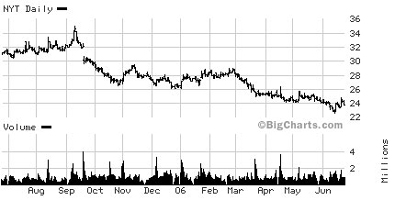The New York Times: Searching for the 'Dough' offline

The New York Times’ Richard Siklos outlines how traditional media companies are “Waiting for the Dough on the Web” in his “Media Frenzy” piece today:
one could make a case that the amount of focus on — and hype about — Internet activities at media companies has some kind of inverse relationship to the amount of near-term revenue they represent for these companies. We're still in the early innings, but given how much the Internet has already transformed the media and society, it's surprising how little money traditional media companies make directly from it.
Siklos puts forth a broad strokes review of how the various media conglomerates are positioning themselves, and faring, online. While including “balanced” optimistic and pessimistic scenarios for the traditional media companies, Siklos posits that online operations for some companies:
could serve increasingly as a promotional or marketing outlet, or as a cut-rate but widely distributed version of what consumers can buy in conventional formats…
For now, though, the question of who among the media companies has this Internet thing figured out remains open. But at this time of upheaval and gloom about media's prospects, it is funny to think about how much money there is still to be made in the good old offline world.
It is doubtful however, that Siklos’ own New York Times, cited by Siklos as an example of one of the traditional media companies that “stand out for their online strategies”, finds it “funny” that a UBS analyst recently cast much doubt on “how much money” The New York Times can make in the “good old offline world.”
According to UBS analyst Brian Shipman, as reported by Forbes:
The New York Times Company is particularly vulnerable throughout the northeastern United States…regional economic woes could adversely affect advertising -- the company’s main source of revenue….
National expansion of the company’s flagship paper, the New York Times, may slacken because the pool of subscribers may be reaching its limit. Subscription price increases over the past few years, coupled with growing competition in the New York metro area may also hinder circulation expansion.

UPDATE: "The Incredible Shrinking Newspaper, Newspapers are dying , but the news is thriving," by Jack Shafer:
That high-pitched squealing you hear in the background is the sound of the American newspaper shrinking...
Everywhere, newspapers are chucking stock tables, eliminating such once-venerable features as horse-racing coverage and their own editorial cartoonists, and consolidating or killing sections. For example, The New York Timesjust axed its Sunday television listings guide and has consolidated its Sunday regional sections into one. Much to their distress, newspapers are shedding profitable classified and display advertising. Evaporating circulation, shuttered foreign bureaus, and scaled-back Washington and state capital bureaus complete the miniaturization of the American daily.
If newspapers get any smaller, you'll have to read them with a magnifying glass...
Publicly owned newspapers, most of which are handsomely profitable, blame Wall Street for the dinkification, saying the stock market punishes newspaper companies when their publications don't earn the accustomed 20 percent profit margin.